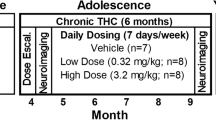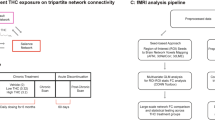Abstract
Reinforcing effects of Δ9-tetrahydrocannabinol (THC), the primary active ingredient in marijuana, as assessed with self-administration (SA), has only been established in New World primates (squirrel monkeys). The objective of this study was to investigate some experimental factors that may enhance intravenous SA of THC and the cannabinoid receptor (CBR) agonist CP 55 940 in Old World monkeys (rhesus and cynomolgus), a species that has been used extensively in biomedical research. In one experiment, male rhesus monkeys (N=9) were trained to respond under a fixed-ratio 10 schedule of food presentation. The effects of CP 55 940 (1.0–10 μg/kg, i.v.) and THC (3.0–300 μg/kg, i.v.) on food-maintained responding and body temperature were determined in these subjects prior to giving them access to self-administer each drug. Both drugs dose-dependently decreased food-maintained responding. CP 55 940 (0.001–3.0 μg/kg) functioned as a reinforcer in three monkeys, whereas THC (0.01–10 μg/kg) did not have reinforcing effects in any subject. CP 55 940 was least potent to decrease food-maintained responding in the monkeys in which CP 55 940 functioned as a reinforcer. Next, THC was administered daily to monkeys until tolerance developed to rate-decreasing effects. When THC SA was reexamined, it functioned as a reinforcer in three monkeys. In a group of cocaine-experienced male cynomolgus monkeys (N=4), THC SA was examined under a second-order schedule of reinforcement; THC functioned as reinforcer in two monkeys. These data suggest that SA of CBR agonists may be relatively independent of their rate-decreasing effects in Old World monkeys. Understanding individual differences in vulnerability to THC SA may lead to novel treatment strategies for marijuana abuse.
Similar content being viewed by others
Log in or create a free account to read this content
Gain free access to this article, as well as selected content from this journal and more on nature.com
or
References
Azofeifa A, Mattson ME, Schauer G, McAfee T, Grant A, Lyerla R (2016). National estimates of marijuana use and related indicators — National Survey on Drug Use and Health, United States, 2002–2014. MMWR Surveill Summ 65: 1–25.
Beardsley PM, Balster RL, Harris LS (1986). Dependence on tetrahydrocannabinol in rhesus monkeys. J Pharmacol Exp Ther 239: 311–319.
Carney JM, Uwaydah IM, Balster RL (1977). Evaluation of a suspension system for intravenous self-administration of water insoluble substances in the rhesus monkey. Pharmacol Biochem Behav 7: 357–364.
Dewey WL, McMillan DE, Harris LS, Turk RF (1973). Distribution of radioactivity in brain of tolerant and nontolerant pigeons treated with 3H-Δ9-tetrahydrocannabinol. Biochem Pharmacol 22: 399–405.
Fan F, Compton DR, Ward S, Melvin L, Martin BR (1994). Development of cross- tolerance between delta 9-tetrahydrocannabinol, CP 55,940 and WIN 55,212. J Pharmacol Exp Ther 271: 1383–1390.
Fattore L, Cossu G, Martellotta CM, Fratta W (2001). Intravenous self-administration of the cannabinoid CB1 receptor agonist WIN 55,212-2 in rats. Psychopharmacology 156: 410–416.
Ghozland S, Mathews H, Simonin F, Filliol D, Kieffer BL, Maldonado R (2002). Motivational effects of cannabinoids are mediated by - and k-opioid receptors. J Neurosci 22: 1146–1154.
Gifford AN, Bruneus M, Lin S, Goutopoulos A, Makriyannis A, Volkow ND et al (1999). Potentiation of the action of anandamide on hippocampal slices by the fatty acid amide hydrolase inhibitor, palmitylsulphonyl fluoride (AM 374). Eur J Pharmacol 383: 9–14.
Ginsburg BC, Hruba L, Zaki A, Javors MA, McMahon LR (2014). Blood levels do not predict behavioral or physiological effects of Δ9-tetrahydrocannabinol in rhesus monkeys with different patterns of exposure. Drug Alcohol Depend 139: 1–8.
Haertzen CA, Kocher TR, Miyasato K (1983). Reinforcements from the first drug experience can predict later drug habits and/or addiction: results with coffee, cigarettes, alcohol, barbiturates, minor and major tranquilizers, stimulants, marijuana, hallucinogens, heroin, opiates and cocaine. Drug Alcohol Depend 11: 147–165.
Harris RT, Waters W, McLendon D (1974). Evaluation of reinforcing capability of Δ9-tetrahydrocannabinol in monkeys. Psychopharmacologia 37: 23–29.
Hunt CA, Jones RT (1980). Tolerance and disposition of tetrahydrocannabinol in man. J Pharmacol Exp Ther 215: 35–44.
John WS, Banala AK, Newman AH, Nader MA (2015a). Effects of buspirone and the dopamine D3 receptor compound PG619 on cocaine and methamphetamine self-administration in rhesus monkeys using a food-drug choice paradigm. Psychopharmacology (Berl) 232: 1279–1289.
John WS, Newman AH, Nader MA (2015b). Differential effects of the dopamine D3 receptor antagonist PG01037 on cocaine and methamphetamine self-administration in rhesus monkeys. Neuropharmacology 92: 34–43.
Justinova Z, Mascia P, Wu H-Q, Secci ME, Redhi GH, Panlilio L et al (2013). Reducing cannabinoid abuse and preventing relapse by enhancing endogenous brain levels of kynurenic acid. Nat Neurosci 16: 1652–1661.
Justinova Z, Munzar P, Panlilio LV, Yasar S, Redhi GH, Tanda G et al (2008). Blockade of THC-seeking behavior and relapse in monkeys by the cannabinoid CB(1)-receptor antagonist rimonabant. Neuropsychopharmacology 33: 2870–2877.
Justinova Z, Tanda G, Redhi GH, Goldberg SR (2003). Self-administration of delta(9)-tetrahydrocannabinol (THC) by drug naive squirrel monkeys. Psychopharmacology 169: 135–140.
Kangas BD, Leonard MZ, Shukla VG, Alapafuja SO, Nikas SP, Makriyannis A et al (2016). Comparisons of Δ9-tetrahydrocannabinol and anandamide on a battery of cognition-related behavior in nonhuman primates. J Pharmacol Exp Ther 357: 125–133.
Kaymakcalan S (1972). Physiology and psychological dependence on THC in rhesus monkeys. In: Paton WDM, Crown J (eds). Cannabis and its Derivatives. Oxford University Press: London. pp 142–149.
Kaymakcalan S (1973). Tolerance to and dependence on cannabis. Bull Narc 25: 39–47.
Kirk JM, De Wit H (1999). Responses to oral delta9-tetrahydrocannabinol in frequent and infrequent marijuanausers. Pharmacol Biochem Behav 63: 137–142.
Lefever TW, Marusich JA, Antonazzo KR, Wiley JL (2014). Evaluation of WIN 55,212-2 self-administration in rats as a potential cannabinoid abuse liability model. Pharmacol Biochem Behav 118: 30–35.
Leite JR, Carlini EA (1974). Failure to obtain “cannabis directed behavior” and abstinence syndrome in rats chronically treated with cannabis sativa extracts. Psychopharmacologia 36: 133–145.
Lepore M, Vorel SR, Lowinson J, Gardner EL (1995). Conditioned place preference induced by D9-tetrahydrocannabinol: comparison with cocaine, morphine, and food reward. Life Sci 56: 2073–2080.
Li J-X, Koek W, France CP (2012). Interactions between Δ(9)-tetrahydrocannabinol and heroin: self-administration in rhesus monkeys. Behav Pharmacol 23: 754–761.
Lindgren JE, Ohlsson A, Agurell S, Hollister L, Gillespie H (1981). Clinical effects and plasma levels of delta 9-tetrahydrocannabinol (delta 9-THC) in heavy and light users of cannabis. Psychopharmacology 74: 208–212.
Mansbach RS, Nicholson KL, Martin BR, Balster RL (1994). Failure of Δ9-tetrahydrocannabinol and CP 55,940 to maintain intravenous self administration under a fixed-interval schedule in rhesus monkeys. Behav Pharmacol 5: 219–225.
Martellotta MC, Cossu G, Fattore L, Gessa GL, Fratta W (1998). Self-administration of the cannabinoid receptor agonist WIN 55,212–2 in drug-naive mice. Neuroscience 85: 327–330.
Martin BR, Dewey WL, Harris LS, Beckner JS (1976). 3H-Δ(9)-tetrahydrocannabinol tissue and subcellular distribution in the central nervous system and tissue distribution in peripheral organs of tolerant and nontolerant dogs. J Pharmacol Exp Ther 196: 128–144.
McMahon LR (2011). Chronic delta9-tetrahydrocannabinol treatment in rhesus monkeys: differential tolerance and cross-tolerance among cannabinoids. Br J Pharmacol 162: 1060–1073.
McMillan DE, Dewey WL, Turk RF, Harris LS, McNeil JH (1973). Blood levels of 3H-D9-tetrahydrocannabinol and its metabolites in tolerant and nontolerant pigeons. Biochem Pharmacol 22: 383–397.
Nader MA, Lile JA, John WS, Czoty PW (2015) Nonhuman primate models of abuse liability. In Weinbauer GF, Vogel F (eds). “Primate Biologics Research at a Crossroads”. Waxmann Publishing Co: Muenster, Germany. pp 37–59.
Paronis CA, Nikas SP, Shukla VG, Makriyannis A (2012). Δ9-Tetrahydrocannabinol acts as a partial agonist/antagonist in mice. Behav Pharmacol 23: 802–805.
Perez-Reyes M, White WR, McDonald SA, Hicks RE, Jeffcoat AR, Cook CE (1991). The pharmacologic effects of daily marijuana smoking in humans. Pharmacol Biochem Behav 40: 691–694.
Pickens R, Thompson T, Muchow DC Cannabis and phencyclidine self-administered by animals (1973) Goldfarb L, Hoffmeister F (eds). Psychic dependence [Bayer-Symposium IV]. Springer: Berlin Heidelberg New York. pp 78–86.
Rodriguez JS, McMahon LR (2014). JWH-018 in rhesus monkeys: differential antagonism of discriminative stimulus, rate-decreasing, and hypothermic effects. Eur J Pharmacol 740: 151–159.
SAMHSA (2014). Substance Abuse and Mental Health Services Administration. Results from the 2013 National Survey on Drug Use and Health: Overview of findings. NSDUH series H-48, HHS Publication No. (SMA) 14-4863. Substance Abuse and Mental Health Services Administration: Rockville, MD.
Scherma M, Dessì C, Muntoni AL, Lecca S, Satta V, Luchicchi A et al (2016). Adolescent Δ9-tetrahydrocannabinol exposure alters WIN55,212-2 self-administration in adult rats. Neuropsychopharmacology 41: 1416–1426.
Siemens AJ, Kalant H (1974). Metabolism of delta1-tetrahydrocannabinol by rats tolerant to cannabis. Can J Physiol Pharmacol 52: 1154–11566.
Stewart JL, McMahon LR (2010). Rimonabant-induced Δ9-THC withdrawal in rhesus monkeys: discriminative stimulus effects and other withdrawal signs. J Pharmacol Exp Ther 334: 347–356.
Tanda G, Munzar P, Goldberg SR (2000). Self-administration behavior is maintained by the psychoactive ingredient of marijuana in squirrel monkeys. Nat Neurosci 3: 1073–1074.
Thomas H (1996). A community survey of adverse effects of cannabis use. Drug Alcohol Depend 42: 201–207.
Valjent E, Maldonado R (2000). A behavioural model to reveal place preference to Δ9-tetrahydrocannabinol in mice. Psychopharmacology 147: 436–438.
Van Ree JM, Slangen JL, de Wied D (1978). Intravenous self- administration of drugs in rats. J Pharmacol Exp Ther 204: 547–557.
Acknowledgements
We thank Michael Coller and Susan Nader for assistance throughout this project and Paul Czoty, Linda Porrino and Jenny Wiley for helpful discussions. We also thank Drs. Gianluigi Tanda and Amy Newman for their assistance with initiating these experiments. WSJ, TJM and MAN designed the studies. WSJ conducted the experiments and analyzed the data. WSJ, TJM and MAN wrote the manuscript.
Author information
Authors and Affiliations
Corresponding author
Additional information
Supplementary Information accompanies the paper on the Neuropsychopharmacology website
Supplementary information
Rights and permissions
About this article
Cite this article
John, W., Martin, T. & Nader, M. Behavioral Determinants of Cannabinoid Self-Administration in Old World Monkeys. Neuropsychopharmacol 42, 1522–1530 (2017). https://doi.org/10.1038/npp.2017.2
Received:
Revised:
Accepted:
Published:
Issue date:
DOI: https://doi.org/10.1038/npp.2017.2
This article is cited by
-
Potential of Cannabinoid Receptor Ligands as Treatment for Substance Use Disorders
CNS Drugs (2019)
-
Effects of repeated treatment with methcathinone, mephedrone, and fenfluramine on intracranial self-stimulation in rats
Psychopharmacology (2019)
-
Clinical and Preclinical Evidence for Functional Interactions of Cannabidiol and Δ9-Tetrahydrocannabinol
Neuropsychopharmacology (2018)
-
Preclinical Studies of Cannabinoid Reward, Treatments for Cannabis Use Disorder, and Addiction-Related Effects of Cannabinoid Exposure
Neuropsychopharmacology (2018)
-
CB1 Receptor Activation on VgluT2-Expressing Glutamatergic Neurons Underlies Δ9-Tetrahydrocannabinol (Δ9-THC)-Induced Aversive Effects in Mice
Scientific Reports (2017)



